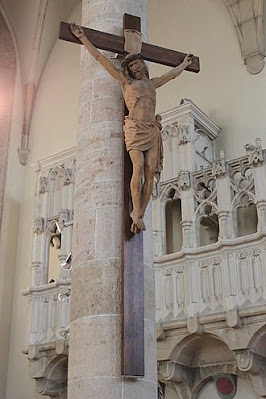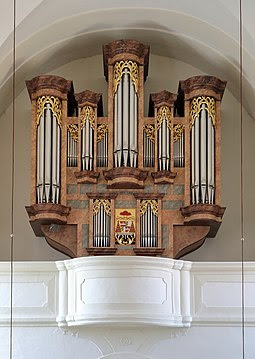Basilicas in Austria—East
Basilica of St. Mary Rotunda, Vienna, Vienna
Declared a minor basilica by Pope Pius XI in 1927.
The Baroque church was built by the Dominicans between 1631 and 1634 on the site of two earlier churches. The ornate church has ceiling frescoes and 8 side chapels.
All pictures are from Wikipedia.
Basilica of Our Lady, Klosterneuburg, Niederosterreich
Declared a minor basilica by Pope Pius XI in 1936.
Klosterneuburg Abbey was built in the early 12th Century by Leopold, then a local ruler and now the patron saint of Austria. The Abbey church was completed in 1136 and was remodeled in a Baroque style between 1634 and 1645. The abbey survived the Protestant Reformation and two attacks by the Ottomans and much of the abbey itself was rebuilt in the 19th Century. It fared less well in the 20th Century. The Nazis confiscated the Abbey and allowed only a few canons to stay and serve the people. Some canons were killed for being in the Nazi resistance. Still others died after the War defending Austrian women and girls from Russian soldiers. The Abbey church (the Basilica) contains the Verdun Altar made in 1181. It has three parts containing 51 gilded copper plates which illustrate Biblical stories.
All pictures are from Wikipedia.
Basilica of Our Lady of Sorrows, Maria Taferl, Niederosterreich
Declared a minor basilica by Pope Pius XII in 1947.
After miraculous healings were reported on this site in the mid—1600s, one of those healed donated a carved Pieta. A chapel was soon built and the current church was constructed between 1660 and 1711. The Baroque church is located 765 feet above the Danube River and has several murals.
All pictures are from Wikipedia.
Basilica of Maria Treu (Faithful Mary), Vienna, Vienna
Declared a minor basilica by Pope Pius XII in 1949.
The church was constructed in the 18th Century by the Order of Piarists. The Baroque church has frescoes by Franz Anton Maulbertsch and a pipe organ associated with composer Anton Bruckner.
All pictures are from Wikipedia.
Basilica of Our Lady, Geras, Niederosterreich
Declared a minor basilica by Pope Pius XII in 1954.
Geras Abbey dates to 1153. The Abbey church (the basilica) was rebuilt after the Thirty Years War in the 17th Century. Initially Romanesque in design, Baroque elements were later added.
Both pictures are from local sources.
Basilica of Maria Dreieichen, Mold, Niederosterreich
Declared a minor basilica by Pope Pius XII in 1957.
A small chapel was built in the 17th Century to house a wooden statue of Mary. The chapel was replaced by the current church in the 18th Century.
From a local source, Wikipedia, and Dreamstime.
Basilica of Our Lady of the Scots, Vienna, Vienna
Declared a minor basilica by Pope Pius XII in 1958.
The church dates to around 1200 but has been renovated and remodeled several times most notably in the 17th Century when the Romanesque building became Baroque. The 19th Century brought about neo-Renaissance and neo-Baroque elements. The church has a 13th Century statue of Our Lady of the Scots which is the oldest depiction of the Virgin Mary in Vienna.
Both are from Wikipedia.
Basilica of the Holy Trinity and St. Michael, Sonntagberg, Niederosterreich
Declared a minor basilica by Pope Paul VI in 1964.
Pilgrims have come to this site on a hill since the 15th Century due to an image of the Holy Trinity—miracles have been said to have occurred. A small chapel was built here in 1440 which was replaced by the current Baroque church in the early 18th Century. The pipe organ was built between 1774 and 1777.
All pictures are from Wikipedia.
Cathedral Basilica of St. George, Wiener Neustadt, Niederosterreich
Declared a minor basilica by Pope Paul VI in 1967.
The church, which is part of a castle, was built in the 15th Century. A military academy was established in the castle in 1751 and continues today. Because of the military connection, the castle and church was largely destroyed during the Second World War but were rebuilt by 1958. Since 1963 the castle and church have been the headquarters of Austria’s Military Ordinariate, hence the church’s status as a cathedral. Maximilian, Holy Roman Emperor (1459—1519), is buried in the Basilica.
The first picture is from Dreamstime and the rest from Wikipedia.
Basilica of the Assumption of Mary, Lilienfeld, Niederosterreich
Declared a minor basilica by Pope Paul VI in 1976.
Lilienfeld Abbey is a Cistercian monastery that was established in 1202. The abbey became a center for the Counter-Reformation in the 17th Century and in the same century the monks and local people fought off the Turks and Tatars. A fire destroyed most of the complex in 1810 but it was soon rebuilt. The Abbey went through hard times during the Depression of the 1930s and during Nazi control. A Soviet commander spared it from destruction and looting during the Soviet post-war occupation.
All pictures are from Wikipedia.
Basilica of the Nativity of the Blessed Virgin Mary, Maria Roggendorf, Niederosterreich
Declared a minor basilica by Pope John Paul II in 1988.
The Baroque church was built in the early 1650s as a pilgrimage church.
All pictures are from Wikipedia.
Basilica of the Assumption of Mary, Frauenkirchen, Burgenland
Declared a minor basilica by Pope John Paul II in 1990.
A church dating at least to the 14th Century was destroyed by the Turks in 1529. It was rebuilt and once again destroyed by the Turks in 1683. The current Baroque church was completed in 1702.
All pictures are from Wikipedia.
Basilica of Our Lady of Loreto, Loretto, Burgenland
Declared a minor basilica by Pope John Paul II in 1997.
A chapel was built here in 1431 but was destroyed by the Turks in 1529. A new chapel was later built but this too was destroyed by the Turks in 1683. The current Baroque church was consecrated in 1707 and is part of a complex that includes a monastery and cloister, as well as a Loreto Chapel. The Chapel is a replica of the one in Italy.
The first picture is from a local source and the others are from Wikipedia.
Basilica of the Assumption of Our Lady, Klein-Mariazell, Niederosterreich
Declared a minor basilica by Pope Benedict XVI in 2007.
A monastery was built at this site in 1136 with a small wooden church. A more substantial church was completed at the beginning of the 13th Century. The church was expanded and renovated and in the mid-1700s was renovated in a Baroque style. Shortly after this renovation, the monastery was closed by Emperor Joseph II. The church is now a parish church.
The first picture is from a local source and the others are from Wikipedia.
Basilica of the Visitation of Mary, Gussing, Burgenland
Declared a minor basilica by Pope Francis in 2013.
A monastery was built on this site in 1157 and later became a castle. A second monastery was built in the 15th Century but was taken over by Protestants in 1576. Catholics regained the property in 1634. A new monastery and the current church were built in the 1640s. The church is the burial place of Blessed Ladislaus Batthyány-Strattmann, an early 20th Century physician noted for his work with the poor. The monastery library has a copy of a 1476 book by Bartholomaus Metlinger which is considered to be the second oldest pediatric book in world literature.
All pictures are from Wikipedia.



















































No comments:
Post a Comment